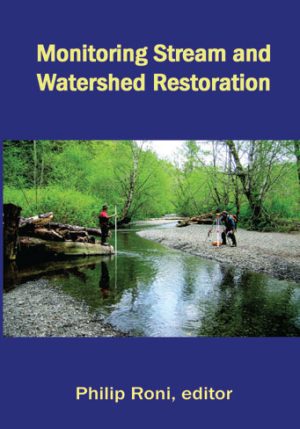Watershed Restoration: Principles and Practices
$0.00 – $46.00
Description
Jack E. Williams, Christopher A. Wood, and Michael P. Dombeck, editors
549 pages; 41 color photographs
Published by American Fisheries Society
Publication date: 1997
doi: https://doi.org/10.47886/9781888569049
Summary
Human demand on our natural resources continues to grow as aquatic and riparian ecosystems continue to decline. Virtually all watersheds have been modified or degraded by human development, often resulting in loss of high-quality water, productive soil, and loss of diverse plant and animal communities. Watershed restoration is a fundamental element of the new ecosystem management philosophy. But what is it? What makes it successful? Who carries it out? The authors and editors of this practical guidebook answer these questions and outline an approach to watershed restoration that combines educating communities about the importance of healthy watershed, a standardized scientific approach to restoration, learning from existing case studies, and the principles of adaptive management.
In straightforward, easy-to-understand language, Watershed Restoration: Principles and Practices will give you an in-depth understanding of the principles of watershed restoration, how to build partnerships for a restoration program, practices and strategies for achieving restoration, what works and what does not, and what is in store for the future.
In addition to providing the scientific, social, and policy frameworks for conducting restoration, the book spotlights how citizen groups, communities, conservation coalitions, private interests, and management agencies are working together to restore watersheds. Case studies address urbanized watershed, farmlands, forestlands, rangelands, and large river systems from New England to California. A critique of these restoration projects summarizes the approaches that offer the best opportunities for long-term success.
This book includes:
* 28 chapters by leaders in the conservation, research, and resource management communities * 41 color photographs; 85 charts and illustrations * comprehensive bibliography * glossary * detailed subject index
This book is intended for:
* fisheries or conservation biologist * hydrologist, rangeland, forest, or riparian ecologist * landscape planner * natural resource manager * leader of a civic organization, or… * somebody engaged in or concerned with habitat restoration
Table of Contents
Chapter 1: Understanding Watershed-Scale Restoration J. E. Williams, C. A. Wood, and M. P. Dombeck
PART I – Principles
Chapter 2: Ethical Principles E. P. Pister
Chapter 3: Social Ecology: A New Pathway to Watershed Restoration K. Preister and J. A. Kent
Chapter 4: Conceptual Roles of Biological Integrity and Diversity P. L. Angermeier
Chapter 5: Historical Perspectives R. C. Wissmar
Chapter 6: Temporal and Spatial Scales R. R. Ziemer
Chapter 7: Ecological Principles C. A. Frissell
Chapter 8: Monitoring and Adaptive Management J. L. Kershner
PART II – Building Collaborative Partnerships for Watershed Restoration
Chapter 10: Building Public and Private Partnerships W. Tilt and C. A. Williams
PART III – Key Practices to Achieve Watershed Restoration
PART IV – Watershed Restoration Case Studies
Chapter 23: Restoring Trout Waters in the West: Big Blackfoot River of Montana G. Aitken
PART V – Learning from the Past to Provide a Vision for the Future
Chapter 26: What Works, What Doesn’t, and Why J. McGurrin and H. Forsgren
Chapter 27: Saving and Creating Jobs Through Watershed Restoration B. Doppelt







